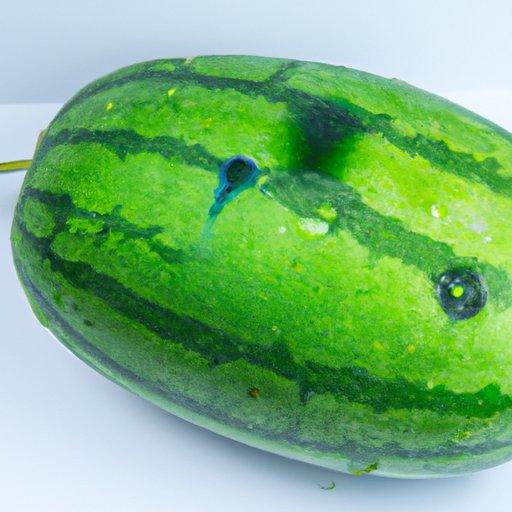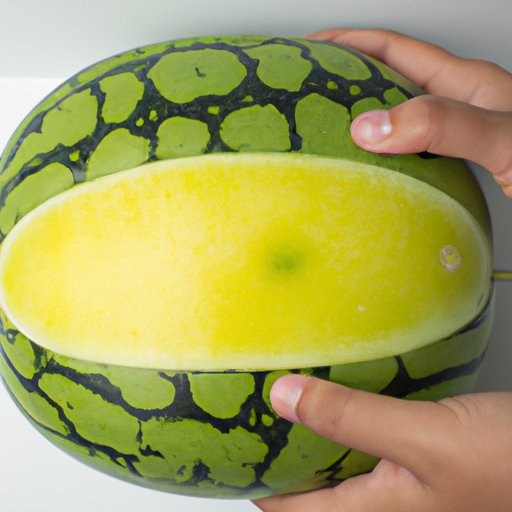
I. Introduction
Watermelon is a refreshing and healthy summer fruit enjoyed by many, but there is nothing worse than biting into a bad watermelon. Being able to identify whether a watermelon has gone bad is crucial to avoid wasting money and risking digestive issues. This article aims to provide you with the necessary knowledge and skills to help you determine if a watermelon is good or bad.
II. Look for Visible Signs of Decay or Damage on the Surface of the Watermelon
One of the easiest ways to tell if a watermelon has gone bad is by inspecting its surface for any visible signs of decay or damage. Soft spots or areas that look discolored or sunken may indicate that the flesh inside has started to spoil. Mold or fungus growths are also signs that a watermelon is no longer fresh. If you notice any of these signs, it’s best to avoid purchasing or consuming the watermelon.
III. Tap on the Watermelon and Listen for a Hollow Sound
Another helpful trick to determine if a watermelon is good is by tapping on it and listening for a hollow sound. Ripe watermelons have a hollow cavity inside, which produces a distinctive sound when tapped. To properly tap a watermelon, use the pads of your fingers and knock on different parts of the surface. If you hear a dull or flat sound, it may indicate that the flesh inside is overripe or underripe.
IV. Check the Stem for Dryness or Signs of Decay
The stem of a watermelon can provide several clues about its freshness. A dry and withered stem indicates that the watermelon was harvested when ripe and is likely to be fresher. On the other hand, a green stem may indicate that the fruit was harvested prematurely, leading to poor taste and texture. Additionally, if the stem shows any signs of decay or mold, it’s best to avoid the watermelon altogether.

V. Check the Bottom of the Watermelon for a Yellow Spot
A yellow spot on the underside of a watermelon is a sign that it has fully ripened on the ground before being harvested. This spot should be creamy and can vary in size. Watermelons without a yellow spot have not fully ripened yet and may not be as flavorful or sweet. It’s important to note that not all watermelons have a yellow spot, particularly if they are a different variety or were grown somewhere with different conditions.
VI. Check the Color of the Flesh
The color of the flesh inside a watermelon can indicate whether it is ripe or not. Ideally, watermelon flesh should be bright pink or red, with no white streaks. Any yellow or greenish tones may indicate that the watermelon is underripe. However, it’s important to note that some varieties have a yellowish or orange flesh on purpose, and that color does not necessarily mean the watermelon has gone bad.
VII. Smell the Watermelon for Any Pungent or Sour Odors
Before cutting into a watermelon, you can also smell it for any unusual odors. A bad watermelon may give off a pungent or sour smell, which is a sign of spoilage. A slightly sweet aroma is an indicator of ripeness and freshness, while no smell at all may mean the watermelon is underripe.
VIII. Cut a Small Piece of the Watermelon and Taste It
If you’re still unsure if a watermelon is good, you can cut a small piece and taste it. Ideally, a ripe watermelon should be juicy, sweet, and flavorful, with a slightly grainy texture. If the flesh is dry or tasteless, it may indicate that the watermelon is not fresh. If the taste is sour or bitter, it’s best to avoid the watermelon altogether.
IX. Conclusion
By following the tips outlined in this article, you can confidently identify if a watermelon is good or bad. Remember to inspect the surface for visible signs of decay or damage, tap on the watermelon, check the stem and bottom, look at the flesh color, smell it for unusual odors, and taste a small piece if necessary.




